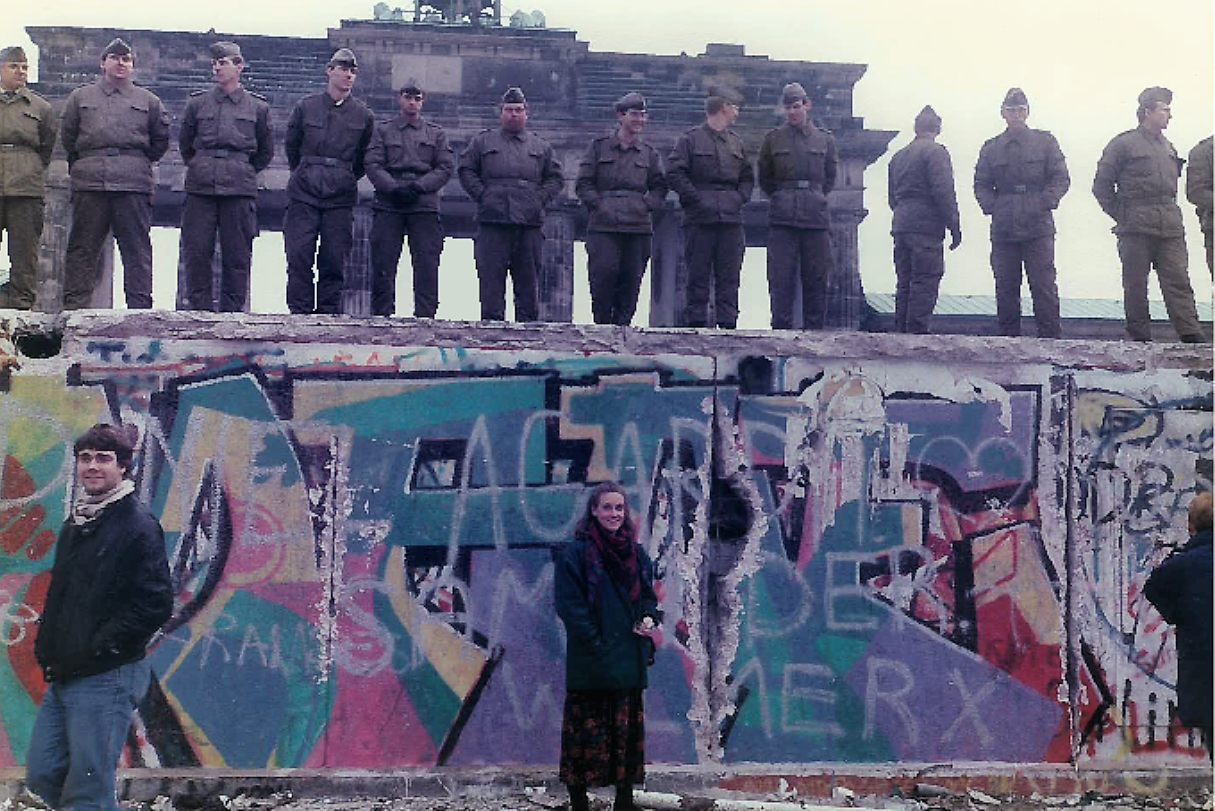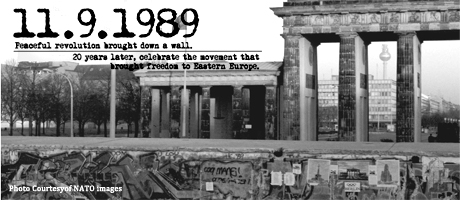By Ruth Steinhardt
Hope M. Harrison was a graduate student writing her doctoral thesis on the building of the Berlin Wall when the city of West Berlin invited her and other young scholars to visit in November 1989. But on her connecting flight from Frankfurt to West Berlin, she saw her fellow passengers reading headlines that would change the course of her scholarship—and of history.
“I looked around and saw everyone reading newspapers with banner headlines that said, ‘Die Mauer ist offen,’ or ‘The Wall is open,’” said Dr. Harrison, now an associate professor of history and international affairs at the George Washington University. “I wondered, ‘Is my German not as good as I think it is? What is going on?’”
Then the intercom clicked, and the pilot made an announcement.
“Ladies and gentlemen: In case you haven’t heard, the Berlin Wall fell last night, and we are flying into history!”
Thirty years later, Dr. Harrison is a prolific scholar of the wall and its legacy. Her latest book, “After the Berlin Wall: Memory and the Making of the New Germany, 1989 to the Present,” published by Cambridge University Press, examines the ways Germany has grappled with the history and legacy of the Berlin Wall since its destruction.
“Germany is always careful to say that it doesn’t presume to serve as a model for others,” she said, while noting that Germany has confronted and atoned for the atrocities of the Holocaust in a comprehensive way. “But there’s no question that it is a model for how a country really forthrightly confronts the difficult parts of its past.”
In the chaotic days immediately after the fall of the Berlin Wall, thousands and then millions of East German citizens flooded into the city. Dr. Harrison watched in awe as a bulldozer removed a section of the wall at Potsdamer Platz, opening a path for East Germans to drive or walk through. West Germans showered the new arrivals with hugs, flowers, money and sparkling wine. Grocery trucks camped at breaks in the wall, distributing free bananas and coffee—neither of which was easy to come by in East Berlin.
“Everyone was cheering and/or crying tears of joy,” Dr. Harrison said.
Given the generally elated atmosphere, it was perhaps unsurprising that East Germans voted overwhelmingly, in 1990, to fast-track reunification with their Western counterparts. But the legacy of that reunification has become fraught in the intervening decades. Some surveys suggest that the majority of East Germans now believe the process was a failure.
“Germans and others at the time didn’t realize what a complicated transition it was going to be from communism to democracy and capitalism, and that was and is true in other former communist states as well,” Dr. Harrison said. “There are ways in which the East still lags behind, psychological divisions between East and West Germans, and some East Germans feel they are second class citizens.”
Public narrative related to the history of the Berlin Wall has been affected by what Dr. Harrison calls “memory activists”—the politicians, scholars, activists and others who helped shape public memory of the Berlin Wall. That includes clergy, artists, and the families of those who lost their lives in the “death strip” and at other points along the border. And, perhaps unexpectedly, it includes those who enforced the violence there.
“Thirty years after the fall of the wall, Germans are still grappling with the traumatic effect it had on individuals and society as a whole, and that includes many of the young East German border soldiers who served there,” said Dr. Harrison, who interviewed some of those guards for her book. “Some of them have testified to essentially still being traumatized by their experience serving at the border, whether they tried to apprehend someone, or if they shot someone, or actually killed someone. This remains, for some of them, a really difficult history.”
Directly confronting atrocity and listening to a variety of voices is part of creating a more just society, Dr. Harrison said. She cited the National Memorial for Peace and Justice, which memorializes victims of American lynching, as a U.S. equivalent.
“How a country looks at its past is intimately connected to how that country and its citizens are thinking about themselves now,” Dr. Harrison said. “We try to define our history based on who we want to be now and in the future.”
She still remembers the excitement of those days in 1989, even as she feels the distance between that and the current political atmosphere.
“It’s strange to look back at it now, when so many walls are going up,” Dr. Harrison said. “As a historian I feel that there are big pendulum shifts in history, and in 1989 the pendulum was swinging toward democracy. Many thought, ‘This is it! Everything’s going to be great and peaceful!’ And now, 30 years later, the pendulum is swinging the other way in many places. It’s like looking back at another time—what feels like a happier time, and certainly a more open time.”



